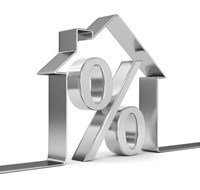As only about a month ago, two major banks stated they expected rates to rise only in 2015, the half point increase in the repo rate, announced by the Reserve Bank last week, sent a shock wave through markets. In general, sentiment had been for the current five-year standstill in the repo rate to continue until the end of this year.

© fotomek - Fotolia.com
However, Reserve Bank governor, Gill Marcus expressed concerns about the weak rand's impact on inflation, reminding the public that the bank's brief is to try to keep inflation within its target range of 3% to 6%. The bank now expects inflation to break out above 6% in the second half of the year and to carry on well into next year, peaking at 6.5%.
This suggests at most another half a percent rise in the repo rate may occur towards year-end. For the property market, the interest rate hike is more of a confidence-shaker than anything else is; it moves the prime (mortgage) rate to 9%, which on a million rand bond is roughly an extra R320 on the monthly repayment. The big question is whether the hike heralds the beginning of an upward turn in the interest rate cycle... This would not be good for the current market, which is moving along quite nicely. However, for the cautious, switching to a fixed interest rate bond is always an alternative...
National budget
Minister of Finance Pravin Gordhan may introduce some tax relief in the National Budget that will help counter the effects of the higher mortgage bond repayments.

Pam Golding chief executive, Dr Andrew Golding
"Looking at the residential market overall, sales price growth in 2013 reached its highest peak since 2009 and prospects for house value growth this year are encouraging, if modest," says Andrew Golding, chief executive of Pam Golding Properties. "A knock-on effect of higher interest rates could create a degree of house price inflation.
"Of note among overall market trends has been a revival in the market for holiday homes which experienced unexpected good sales from mid-November 2013 to mid-January 2014.
"Underpinning the market buoyancy is the fact that both the buying and rental markets are experiencing significant supply shortages, particularly among those in the middle income range."
Appeal for buy-to-let investors
An important aspect for both markets is whether rental yields are reaching an attractive level for aspirant buy-to-let investors. Michelle Dickens, managing director of TPN Credit Bureau, which with First National Bank produces a national average rental yield index, believes this has begun to occur.
"The positive thing is that the attractiveness appears once again to be improving on both scores (yield and costs). In addition to the mild increase in yields, tenants have become more reliable payers as the economic recession of 2008/9 has faded."
Other factors contributing to the improving residential market outlook include greater affordability, particularly at the lower levels, fewer stress-related sales and marginally easier credit criteria imposed by the mortgage lending banks. Nevertheless, consumer debt remains a worry and growth in disposable income is slowing. Furthermore, as Gill Marcus points out, the outlook for the economy is bleak. GDP growth this year might just manage 2%.
Industry Minister, Rob Davies welcomes a weaker rand. It helps boost exports, mainly mining, and thus goes some way to alleviate our negative balance of payments. However, currency devaluation is an easy way out and no substitute for productivity.
Repayment costs of credit
The key to a healthier residential property market lies with the banks. A major issue when seeking a mortgage bond is not simply the strict lending criteria laid down by the National Credit Act, it is that while we still have the lowest prime lending rate in decades, consumers face stiff repayment costs for credit, whether involved in a home mortgage bond, vehicle finance or whatever. The National Credit Act, admittedly, places a ceiling (16.5%) on mortgage interest rates, so bondholders will pay somewhere between 9% and 16.5% . Is this low? Hardly, by international standards - or by current disposable income levels.
The average required deposit is also a stiff hill to climb for many aspirant homebuyers, although mortgage broker ooba reports that banks are approving slightly lower deposits (down to 14.66%). One hundred percent bonds are also becoming more common and, according to its data, during 2013 the majority of homes purchased (52.47%) were by first-time buyers, which is good news.
Moreover, stats released by the National Credit Regulator show accelerating growth in mortgage lending. It may well be that as the boom in unsecured credit tapers off, the banks are switching back to mortgage lending as a source of asset growth. Total household credit granted in the third quarter of 2013 rose year-on-year by a modest 3.2%, but the mortgage component of that grew by 20% in value.
Supply side fluctuates
Another key component, in terms of the market outlook, is the supply side. Residential building activity, in both planning and construction, came under pressure towards the end of the year. Construction of new houses dropped 30% in November compared with the previous month and the number of new homes /units for which building plans were passed dropped by 32.4% year-on-year in that month. On the other hand, construction of flats and townhouses surged; completed construction was up 15.4% by October last year (2013).
The current stock restraints being experienced by estate agents are to some extent reflective of weak building activity. "There is a very real shortage of stock in all metropolitan areas and it is a developing trend," says Dr Golding. "This is putting upward pressure on prices."
International buyers show small interest
The free-falling rand, of course, is seen as a potential attraction for international buyers. The cumulative drop since 2011 has been extreme - 19.7% in euro terms, 22.9% to the US dollar and 24% on the pound sterling. In spite of this, combined with relatively inexpensive homes on the market, the foreign buying component is only 3% of total buying, according to First National Bank. African buyers, however, remain active in Gauteng.
International buyers acquiring property in South Africa face a two-way bet. For those who purchased homes some years ago when the rand was relatively strong, selling that property now and remitting the money back to whence it came can mean serious losses in hard currency terms. On the other hand, buying now or in the near future, taking the view that the rand will strengthen, as it has before, can result in a windfall on repatriation for opportunistic buyers.









































